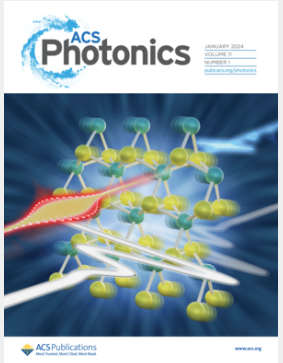Tunable Cavity Coupling to Spin Defects in a 4H-Silicon-Carbide-On-Insulator Platform
IF 6.5
1区 物理与天体物理
Q1 MATERIALS SCIENCE, MULTIDISCIPLINARY
引用次数: 0
Abstract
Silicon carbide (SiC) has attracted significant attention as a promising quantum material due to its ability to host long-lived, optically addressable color centers with solid-state photonic interfaces. The CMOS compatibility of 4H-SiCOI (silicon-carbide-on-insulator) makes it an ideal platform for integrated quantum photonic devices and circuits. While microring cavities have been extensively studied in SiC and other materials, the integration of 4H-SiC spin defects into these critical structures, along with continuous mode tunability, remains unexplored. In this work, we demonstrate the integration of PL4 divacancy spin defects into tunable microring cavities in scalable thin-film 4H-SiC nanophotonics. Comparing on- and off-resonance conditions, we observed an enhancement of the Purcell factor by approximately 5.0. This enhancement effectively confined coherent photons within the coupled waveguide, leading to a 2-fold increase in the ODMR (optically detected magnetic resonance) contrast and coherent control of PL4 spins. These advancements lay the foundation for developing SiC-based quantum photonic circuits.

4h -绝缘体上碳化硅平台中自旋缺陷的可调谐腔耦合
碳化硅(SiC)作为一种有前途的量子材料,由于其具有具有固态光子界面的长寿命、光学可寻址的色中心的能力而引起了人们的极大关注。4H-SiCOI(绝缘体上碳化硅)的CMOS兼容性使其成为集成量子光子器件和电路的理想平台。虽然微环空腔已经在SiC和其他材料中得到了广泛的研究,但将4H-SiC自旋缺陷集成到这些关键结构中,以及连续模式可调性,仍未得到探索。在这项工作中,我们展示了可伸缩薄膜4H-SiC纳米光子学中PL4距离自旋缺陷集成到可调谐微环腔中的方法。比较共振和非共振条件,我们观察到Purcell因子提高了大约5.0。这种增强有效地限制了耦合波导内的相干光子,导致ODMR(光学检测磁共振)对比度和PL4自旋的相干控制增加了2倍。这些进展为开发基于sic的量子光子电路奠定了基础。
本文章由计算机程序翻译,如有差异,请以英文原文为准。
求助全文
约1分钟内获得全文
求助全文
来源期刊

ACS Photonics
NANOSCIENCE & NANOTECHNOLOGY-MATERIALS SCIENCE, MULTIDISCIPLINARY
CiteScore
11.90
自引率
5.70%
发文量
438
审稿时长
2.3 months
期刊介绍:
Published as soon as accepted and summarized in monthly issues, ACS Photonics will publish Research Articles, Letters, Perspectives, and Reviews, to encompass the full scope of published research in this field.
 求助内容:
求助内容: 应助结果提醒方式:
应助结果提醒方式:


